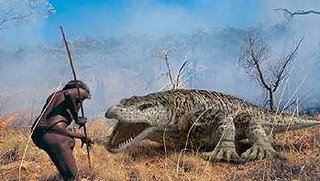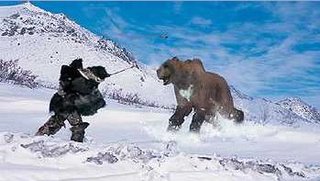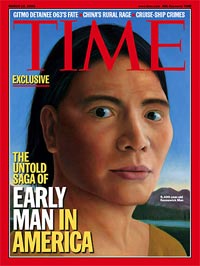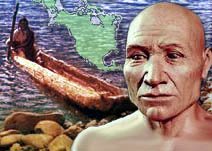BBC MONSTERS WE MEET: NEW ZEALAND
 BBC Monsters we met: New Zealand
BBC Monsters we met: New ZealandThe End of Eden
New Zealand 1280 AD
Kopei a Maori hero, one of the world greatest pioneers, has journeyed from his Polynesian homeland in search of paradise, a land that might offer his people a new and prosperous beginning.
Kopei and his wife are the first humans to discover New Zealand. This is the final frontier the last habitable landmass on earth to be discovered by people. They are venturing into the unknown a lost world where monsters still roam. A world of bizarre creatures ruled by the deadliest aerial predator since the time of the dinosaurs, it’s like a Hitchcock horror.
A forgotten paradise is colonized.
Aboard great canoes a new wave of Polynesian pioneers has voyaged the open oceans to colonize New Zealand, guided by Kopei promise of bountiful islands capped with moisture and sweet scented soil. They named the land Autaaroa, the land of the Long White Cloud. These intrepid explorers will come to be known as the Maori. Pitching up on New Zealand’s shores is a auspicious moment. It is heralded with Karakea a ritual challenge to enemies and evil spirits , a calling for blessings from their spiritual guardians.
Eighteen million years ago at the time Australia and Antarctica where joined a small fragment broke off the super continent and slowly headed into the south Pacific. New Zealand was formed, marooned in splendid isolation. Cut off from the rest of the world a strange and unique set of prehistoric plants and animals has evolved. While medieval Europe is laying its foundations the Polynesian pioneers are discovering a biological wonderland on the other side of the world.
The only species that have reached New Zealand are those that can be carried by the wind or can fly, drift in currents or can swim. Their dreams of discovering Kopeis paradise appears to have come true. Yet now they are here these Polynesians has ambitious plans of reshaping the islands to their own design. They have a proud history of creating dazzling civilizations built on their command of agriculture and gardening. They have transported tropical plants and seeds straight from their homeland with expectations of cultivating New Zealand ’s wilderness. Dogs have arrived and the Kiori a Pacific rat species both are a dependable supply of meat for the Maori. In Maori culture the kiori is their respected and highly sacred possession. Other than a few bats the Maori and their domesticated animals are the first land mammals to set foot in New Zealand. They come from a rich culture. They are a highly creative and devout people. They plant the scared modi stone which hold the mana or life force of their homeland it is a potent symbol they believe will protect them from evil sprits. Like planting a national flag it represents the Maoris’ claim to New Zealand.
The story of the Maori and their occupation of New Zealand will follow the grand themes of mankind’s pioneering history played out in miniature on these isolated islands. It’s a story that gives insight into human nature, it’s a story that represents us all.
A world dominated by birds
So what is this place like, it has no large ground dwelling predators without them feeding and nesting on the ground is safe. Many of the bird have lost the power of flight. In this strange world birds dominate. Here no creatures fear people in their extreme isolation they have never encountered a two legged animal that poses a threat.
Many birds follow the life style normally associated with rabbits deer and mice. There are giants here too. Eleven species of moa patrol the islands. The largest of these species the giant moa is the tallest bird ever to have walked the earth. It is New Zealand equivalent of a giraffe.
Tuatara a living fossil with a primitive third eye, it appeared on earth long before the dinosaurs.
The giant weta’s ancestry travels even further back in time. At least two hundred million years. Their striking appearance and nocturnal habits lead the Maori to call them devils of the night.
When tuataras hunt wetas they engage in at primeval battle witnessed by the dinosaurs.
The Maori settlers take an immediate dislike to these reptiles believing them to be puma the father of ugly things.
The short-tailed bat is a zoological oddity; it is the only bat in the world that lives on the forest floor. Millions of years ago against fantastic odds they were blown here and are now castaways. They rarely use the wings that carried their ancestors here instead much like hedgehogs they scamper the forest floor digging for grubs. The Maori are to become highly superstitious of bats believing them to be harbingers of doom foretellers of death and disaster.
Death from the sky
The Maori soon discover their new found world is far larger than any islands their people have previously occupied. In fact New Zealand is a bigger landmass than all the Polynesian islands put together. Exploring the heavily forested interior it will not be long before they discover the islands top predator, a creature that will come to strike fear in the hearts of the Maori. The Haast eagle the largest and most deadly aerial predator the world has ever seen. It has a three metre wingspan, talons the size of tiger’s claws that will crush the neck of a giant moa, a bird twenty times its weight. This is a specialist in crippling two-legged prey. When it first sets eyes on humans this pre-adapted man killer sees fare game. It swoops down on unsuspecting victims at speeds up to eighty kilometers per hour. This monstrous raptor remains by its kill for days.
The Maori will speak of this giant carrying people away to feed its ravenous young. The haast eagle is terrifying that it will become a sacred totem of kite design. A bird mankind will fly to mark the recent death. The kite climbs to the spiritual world of the Maori ancestors and a toroba is a spiritual leader is a mediator between the natural and the super natural. He sends his spirit with the kite to commune with the gods. The terror bird constantly preys on Maori minds. So great is their fear the monster likeness appears on sacred stones. They dread is chilling cry and name it hokliori believing it call to be a portent of death and war.
Man the hunted becomes man the hunter
Our fear of monster like the Haast eagle is deeply ingrained in our psyche. It originates at the time our vulnerable ancestors were at the mercy of deadly predators. In Africa the birth place of humanity we acquired the basic instinct to fear. Go back three million years and it is more the case of man the hunted than man the hunter. This is the time of Austrolopithicus, the time early humans faced monster everyday of their lives. Life is nasty, brutish and short. Day to day survival is the only concern. As a consequent the brain has evolved only to deal with the present in a world where the future is a distant possibility.
At some point the tables begin to turn. This fragile creature gain the skills to make tools and weapons, the balance of power slowly tips in favour of the human species. Man the hunted becomes man the hunter. Africa is an unforgiving training ground. Over the millennia the animals learn to fear people. Man is becoming the continents to predator. One hundred thousand BC fully modern human are ready to leave their African cradle and start the odyssey across planet earth, an epic journey which will span five continents each one bringing a new set of challenges to survival.
Australia sixty five thousand year ago the time many scientists believe people first set foot on this pristine continent. A continent filled with weird and dangerous animals. Here people enter the land of fire, a land of monsters. The most fearsome reptile is the megalania, a giant predatory lizard that is the closest humans have ever come to meeting a dinosaur. A super-predator that can detect it prey from fifteen kilometers. Armed with murderous bacteria laden teeth that pierce and poison its victims to death.
People continue their perilous invasion of the planet walking into North America thirteen thousand years ago. Here they encounter the land of vicious cats and huge bears, the short faced bear the most powerful mammalian predator ever to have prowled the earth. This animal could even deter people from settling the continent.
Giant moas make a good feast
Twelve thousand years later in the land of the terror bird people once again live in fear of monsters but they also face another overwhelming challenge in this new world. The Maori settlers have underestimated just how different this climate is to their tropical Polynesian homeland. Winter is a new a bitter experience to people acclimatized to the warm air of the tropics. Most of their imported crop have perished they were ill suited to New Zealand’s cold winters.
These early years are bleak times the Maori are on the brink of starvation. They have to adapt quickly or die. The Maori resort to eating ground fern roots although the privileged are allowed to eat dogs and their sacred rats. But New Zealand has a food source beyond the size of anything ever encountered in Polynesia. It will not take long for the Maori to realize that the land they have colonized is a land of naïve animals. Isolation has left these creatures ill-prepared for the refined and deadly skills of the human hunter. The Maori develop a taste for one particular animal the giant moa. A monster bird that lays a bird that lays an egg one hundred times bigger than a hen’s. This great bird also yields succulent drumsticks the size of a cows leg. Unlike the giant animals that evolved in Africa the moa has no innate fear of people they are sitting ducks.
The moa becomes the life blood of the Maori, who after lean times are now prospering in this new world. With the moa providing so much of their energy the Maori population is flourishing.
The birds are expertly prepared and cooked in underground ovens but only the upper third of moa legs are eaten. The rest is dumped on giant rubbish heaps or fest to the burgeoning population of feral dogs.
In a large settlement like this forty people will consume ten thousand moa in only twenty years that is ten birds a week. Perhaps this is the Garden of Eden after all. But they are in fact creating a problem for themselves. The moa can only lay one egg a year and each chick take seven years to reach sexual maturity. The birds simply can’t breed fast enough to keep pace with the Maoris intensive hunting. They are doomed to extinction. Moa bones lie in shallow graves half a million will be butchered and eleven species wiped out in just over a hundred years.
The world will loose one of its most extraordinary animals. In the moa’s wake the giant Haast’s eagle will also disappear incapable of surviving once its main food supply the moa has gone. But that isn’t the end of this story. The Moari have unwittingly unleashed a monster in miniature an ecological time bomb. The kiori released by the Maori when they first arrived will eat twenty one ground dwelling bird species to extinction, birds found nowhere else in the world. But worse is still to come.
The Maori play just a small role in humanity’s total occupation of the planet. The human species is the most versatile animal on earth allowing us to endure, explore and raise great civilizations in every conceivable environment on the planet. It is our greatest triumph but since people like us left Africa about one hundred thousand years ago a bleak patter of mass extinctions has occurred around the world, a pattern that consistently coincides with the arrival of humans.
North America thirteen thousand years ago a Serengeti was it inevitable that human arrival spelt the demisal of all these great creatures or could the story have gone another way? Could North America in the twenty first century still be home to animals like the wooly mammoth, the Columbian mammoth and the mastodont? If so it should also be a land of saber-tooths, giant American scimitar cats and two species of camel. Should Florida today be home to the glyptodont a weird armadillo like creature the size of a VW beetle preyed upon by the jaguar?
As it turns out the first people into the Americas hunted thirty kinds of these huge animals to extinction in just a few hundred years.
Though out history humans have written a rolling wave of extinction , in the case of North America not so long after Columbus claimed he discovered the Americas European hunters arrived on the scene with rapidly repeating guns, w eapons far more deadly than Clovis or Maori spears. Once again history repeats itself only humans are becoming far more efficient killers.
A land of plenty become one of starvation
In Australia humans were prey to reptilian monsters to survive we had to defend ourselves, to survive we had to defend ourselves. We held fire. Fire put us in control with it we changed the landscape to suite our needs and I the process exterminated the monsters we met. New Zealand in the fourteen hundreds the Maori resort to desperate measures. Over-hunting means the Moa are becoming scarce. Fire is used to flush out the forests remaining birds. In relentless pursuit of the moa almost half the forest in the South Island is burnt to the ground. By the fifteenth century New Zealand’s natural resources are dwindling; a land of plenty has become a land of starvation. Tribes compete for depleting resources summertime is dedicated to the god of war. The Maori excel in the art of gorilla warfare. Their aggressive style mimics the style of the fantail the warrior bird in Maori mythology. Before long thousands of heavily defended forts known as Pas spring up stimulated by an upsurge in warfare, a direct response to rapidly declining natural resources. It is at this time the war dance design to instill terror in the enemy is first performed. It is called the Haka meaning stand your ground.
Alien species devastate the land
Soon the Maori were to meet a new enemy invaded from foreign lands appear on the horizon. Just as the Native Americans had to contend with the arrival of Columbus in 1492, the Maori just over two hundred and fifty years later in 1749 meet with another European Captain James Cook arrives aboard HMS Endeavor and a New Wave of colonization begins. Captain Cook claims he has discovered New Zealand and grabs its rich resources for the British crown. The British settlers will weep their own lethal blade across New Zealand. Loggers cut swathes of magnificent trees for ship building and agriculture. With the European settlers come lethal diseases, alcohol and guns, devastating for the Maori and the natural world of New Zealand. Like the Maori before them the Europeans arrive with the ambition of making a home away from home and they succeed, transforming dense forest into a green, pleasant land. As with the Maori and the Kiori they introduce yet more destructive alien plants and animals. The place the Maori called Land of the Long White Cloud will later be nicknamed Land of the Wrong White Crowd.
In the twenty first century sixteen million European sheep munch New Zealand’s imported landscape.
Across Polynesia the pattern continues alien species invaded and devastate every island they colonize. Hawaii deceptively beautiful yet over half the islands exotic plants are imported and have snuffed out the rare and exquisite plants that once lived here. Sixty percent of Hawaii’s have vanished succumbing to the ravenous appetites of European rats.
Alien species like rats when in their own environment rarely cause a problem as their numbers are held in check by their natural predators but let loose in foreign lands free from their predators, they can quickly reach plague proportions. Invaders often choose to snuggle up close to humans. They thrive in Urban and agricultural environments and just like humans they are competitive, versatile and eager to travel.
Humans have become the most successful invasive species. Like weeds we have spread unchecked across the planet. Our population growth has been exponential almost bacterial. Six billion and increasing the human species in insatiable consuming the natural world’s resources at an unsustainable rate, our only recourse has been to improve the natural order. Warping and homogenizing nature into monoculture. Mankind today just as the Maori before fights over dwindling reserves, in the race the grabs earths resources the wave of extinction continues to roll. It is likely that half the earth plant and animal species will vanish by the end to the century.
The Sumatran Rhinoceros is officially classified the living dead, a prehistoric animal with no future. Habitat destruction and over hunting means extinction is a certainty. Is population has plummeted to such critically low levels it can never recover. What you see might as well be a computer generated animation.
Throughout our long struggle we met monsters but once humans learnt to overcome them did we become the monster?
The Maori story may offer a glimmer of hope that humans are capable of redressing the balance. There is evidence that soon after the Moa became extinct the Maori succeeded in looking beyond their immediate needs tot eh fate of their world. Nature reserves were set aside a fiercely guarded. The tohuma human or wise man closed the forest to bird hunters and the land became pana meaning sacred. Animal and plant numbers began of recover. Can the same change of outlook happen in the twenty first century on a global scale, only if man is prepared to learn the lessons of time?
Easter Island the remotest scrap of land on Earth, lost in the Pacific Ocean. Here proud monoliths lie in neglect abandoned by a Polynesian society in ruins. The forests felled the birds gone the soil eroded by farming and the wind.
When the Polynesian arrived here in four hundred AD the island was covered in dense forest steadily was cleared to plant great gardens build canoes and erect these magnificent statues. Within a thousand years a culture that created the only written Polynesian language vanished collapsing into warfare cannibalism and environmental ruin.
Here is the paradox of humans we are capable of such heroic and triumphant creations and yet we are also highly capable of perpetrating such horror on the rest of the natural world.




